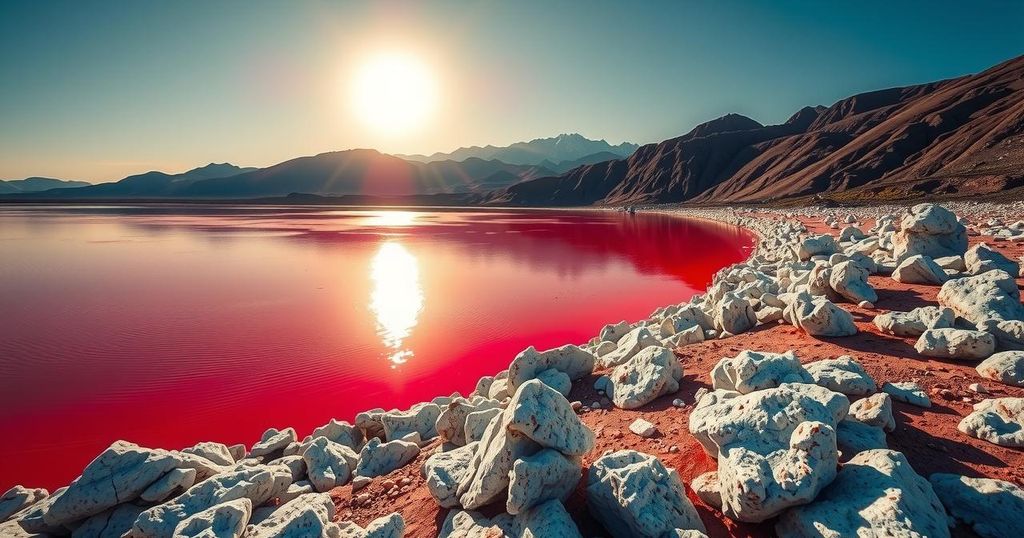Lake Natron: The Strange Red Lake in Tanzania That Turns Animals to Stone
Lake Natron in Tanzania is a striking red lake known for its lethal properties, turning deceased animals into calcified sculptures. Despite its harsh environment, it serves as a crucial breeding ground for lesser flamingos, illustrating the fascinating coexistence of life and death in extreme ecosystems.
Deep in Tanzania, there’s a natural phenomenon that seems ripped from fiction — Lake Natron. This surreal lake, with its striking red hue, not only fascinates onlookers but also has gruesome features. It is one of Africa’s more bizarre creations, known for turning dead animals into what looks like lifeless stone statues. Quite the spectacle, really.
Lake Natron, located in northern Tanzania, boasts a shallow basin filled with caustic water, glowing with a deep crimson shade under the intense sun. This unusual color is a product of specialized microorganisms that thrive in the lake’s alkaline waters. It is these salt-loving haloarchaea and cyanobacteria that generate vibrant red pigments, adapting in a truly extreme environment.
The lake’s composition is harsh. It features a pH level of up to 10.5— nearly as caustic as household ammonia. The conditions here can burn the skin and eyes of most creatures that stray too close. This toxic mix arises from volcanic activity along the East African Rift System, with minerals like sodium and calcium carbonate finding their way into this shallow water body from the neighboring hills and hot springs.
As the hot seasons dry up the lake, it shrinks significantly. This concentrated chemical soup can heat up to 140°F (60°C), creating an atmosphere resembling a bubbling cauldron. While it stretches across nearly nine miles (15 kilometers), its depth averages just 1.6 feet (0.5 meters), which leads to swift evaporation and notable changes with the seasons.
What happens next is rather eerie—animals that meet their demise by the lake undergo a bizarre transformation. When creatures die near the shores of Lake Natron, they become mummified, preserved in a way that makes them appear like lifeless sculptures. The lake’s high sodium carbonate content replaces organic tissues with mineral deposits that create lifelike, stone-like formations.
This incredible and slightly horrifying spectacle was brought to light by photographer Nick Brandt in 2013 with his moving collection “Across the Ravaged Land.” His images, portraying birds and bats seemingly stuck in time, showcased perfectly preserved creatures resembling ghostly monuments of their former selves. The preservation occurs swiftly; water from the lake seeps into the bodies, and as it evaporates, minerals crystallize within.
In some strange turn of nature, Lake Natron is also a haven for life in its own right. This hostile water serves as the prime breeding ground for lesser flamingos (Phoeniconaias minor). These birds, with their unique adaptations, flourish despite the lake’s dangers. They can resist chemical burns thanks to tough scales on their legs, and their beaks are specially designed to extract nutrients from the saline waters.
A staggering 1.5 to 2.5 million lesser flamingos — about 75% of their global total — depend on Lake Natron for reproduction. In the dry season, small islands form where the flamingos can nest, largely protected from predators as few animals dare tread across the toxic lake.
Interestingly, the very microorganisms responsible for Lake Natron’s color also serve as food for the flamingos, giving them the trademark pink plumage seen in these birds. It is a peculiar relationship that highlights how even the harshest environments can cultivate specialized life forms.
As researchers study these extreme ecosystems, they glean insights that might explain how life could potentially exist on other planets. The adaptations found in Lake Natron’s inhabitants are reminiscent of the conditions found on Mars, expanding our understanding of life’s resilience.
For those adventurous souls wanting to explore Lake Natron, proper precautions are necessary. Local guides know where it is safe to stand while observing the vivid waters and flamingo colonies. The surrounding environment contrasts sharply with the lake’s toxicity, featuring healthy salt marshes and wetlands bustling with wildlife like pelicans, ostriches, and wildebeest, all of which provide safer sights for visitors.
Efforts are ongoing to conserve Lake Natron’s unique ecosystem. The Tanzania Wildlife Management Authority imposes stringent regulations to protect flamingo breeding grounds and maintain the chemistry of the lake. Such efforts are crucial to ensuring future generations are able to witness this astounding natural occurrence, where death and life coexist in an extraordinary balance.
To sum it up, Lake Natron stands out as a unique but hazardous gem in Tanzania. While its waters may hold deadly properties, it also serves as an essential breeding ground for lesser flamingos, showcasing nature’s resilience. With the right conservation efforts in place, this remarkable site will continue to intrigue and educate generations to come about the extraordinary adaptations that life can make, even in the harshest conditions.
Original Source: thinkstewartville.com




Post Comment